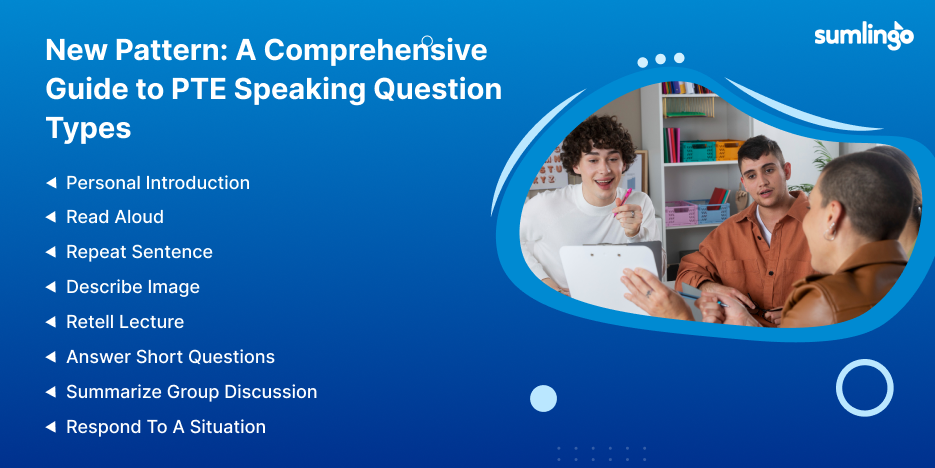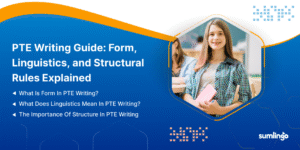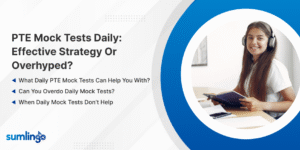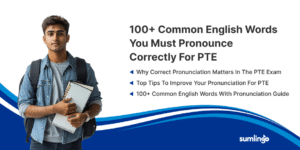The PTE Academic exam assesses various skills, and the Speaking, Writing, Reading, and Listening sections are crucial components. Understanding the question types in these sections can significantly boost your performance. This guide covers all the important question types that you’ll encounter in the Speaking and Writing sections of the PTE exam. After 7th August, this section will have 8 question types, and this section will be of approximately 76- 84 minutes.
The PTE Academic exam assesses various skills, and the Speaking, Writing, Reading, and Listening sections are crucial components. Understanding the question types in these sections can significantly boost your performance. This guide covers all the important question types that you’ll encounter in the Speaking and Writing sections of the PTE exam. After 7th August, this section will have 8 question types, and this section will be of approximately 76- 84 minutes.
1. Personal Introduction
- Number of Questions: 1
- Time: 25 seconds to prepare, 30 seconds to speak.
- Purpose: This section does not count towards your score but helps you get comfortable with the test.
- What to Expect: You’ll be asked to introduce yourself. There’s no need to rush, just speak clearly and confidently.
2. Read Aloud
- Number of Questions: 6–7
- Time: Varies based on the prompt, typically 30–40 seconds to prepare, and then you need to read the text aloud.
- Skills Assessed: Speaking
- What to Expect: A text will appear on the screen, and you must read it aloud after hearing a tone. Ensure that you don’t start speaking before the microphone is open.
- Content Scoring Criteria:
- Each replacement, omission, or insertion of a word counts as one error.
- The maximum score depends on the length of the question prompt.
- If you omit, insert, or mispronounce any word, it will result in a reduction in your score.
Pronunciation and Fluency are scored out of 5 marks
3. Repeat Sentence
- Number of Questions: 10-12
- Time: You will hear a sentence and have 15 seconds to repeat it after listening.
- Skills Assessed: Listening and Speaking
- Total Score: 13
- What to Expect: After listening to a sentence, you need to repeat it exactly as you heard it. The audio will play automatically, and you must start speaking immediately when the recording box opens.
- Content Scoring Criteria:
- Each replacement, omission, or insertion of a word counts as one error.
- Hesitations, filled or unfilled pauses, and leading or trailing material are ignored in scoring content.
Scoring:
- 3: All words in the response from the prompt are in the correct sequence.
- 2: At least 50% of the words in the response from the prompt are in the correct sequence.
- 1: Less than 50% of the words in the response from the prompt are in the correct sequence.
- 0: Almost nothing from the prompt is included in the response.
Pronunciation and Fluency are scored out of 5 marks
Are you ready to test your skills?
4. Describe Image
- Number of Questions: 5-6
- Time: 25 seconds to prepare, 40 seconds to speak.
- Skills Assessed: Speaking
- Total Score: 16
- What to Expect: You’ll see an image and will need to describe it in detail. Focus on what stands out and make sure to describe the relationships between different elements in the image.
Pronunciation and Fluency are scored out of 5 marks Scoring Criteria:
| Score | Content: Trait Scored |
| 6 | ● The response describes the image fully and accurately and expands on the relationships between features of the image to provide a nuanced interpretation. ● A variety of expressions and vocabulary are used appropriately and with ease and precision throughout the response. ● A listener could build a complete mental picture of the image from the response |
| 5 | ● The response describes the main features of the image accurately and identifies some relationships without expanding on these in detail. ● A variety of expressions and vocabulary are used appropriately throughout the response. ● A listener could build an accurate mental picture from the response, with minor details missing or misrepresented. |
| 4 | ● The response includes some accurate, simple descriptions and basic relationships, but they may not adequately cover all the main features of the image. ● The range of linguistic expression and vocabulary is sufficient to give basic descriptions with some repetition. ● A listener could build a basic mental picture from the response. |
| 3 | ● The response includes mainly superficial descriptions of the image, with minor inaccuracies. ● The range of expression and vocabulary is narrow, and simple expressions are used repeatedly. ● A listener could visualize elements of the image from the response, but not a cohesive whole. |
| 2 | ● The response includes minimal, superficial descriptions of the image with some inaccuracies. ● Limited vocabulary and simple expressions dominate the response. ● A listener could visualize some elements of the image from the response with effort. |
| 1 | ● The response is composed of disconnected elements, or a list of points identified on the image, without description or elaboration. ● Vocabulary and expressions are highly restricted. ● A listener would struggle to visualise the image. |
| 0 | Response is relevant to the prompt, but too limited to assign a higher score. |
6. Answer Short Questions
- Number of Questions: 5-6
- Time to Answer: 10 seconds
- Skills Assessed: Listening
- Total Score: 16
- Task Description: After listening to a short question, respond with a single word or a few words.
- Pronunciation and Fluency are scored out of 5 marks.
Scoring Criteria:
| Score | Vocabulary:: Trait Scored |
| 1 | Appropriate word choice in response. |
| 0 | Inappropriate word choice in response. |
7. Summarize Group Discussion
- Number of Questions: 2-3
- Time: 40 seconds to respond.
- Skills Assessed: Speaking
- Total Score: 16
- What to Expect: After listening to a group discussion, you’ll need to summarize the key points and viewpoints expressed during the discussion. The goal is to synthesize different opinions and present them logically.
- Pronunciation and Fluency are scored out of 5 marks
| Score | Content: Trait Scored |
| 6 | ● Response is clear, accurate, and demonstrates full comprehension of the discussion by paraphrasing the main ideas seamlessly in own words and expanding on details of each speaker’s contribution with specificity. Response explores relationships between different points of view and synthesizes different perspectives effectively. ● A variety of expressions and vocabulary are used appropriately and with ease and precision throughout the response. ● The ideas in the response are well-connected and organized in a logical sequence using connective devices effectively and consistently. The response flows well and is easy to follow. |
| 5 | ● Response is clear and accurately captures the main ideas as well as some important details of different speakers’ contributions, reflecting good comprehension. Ideas are formulated successfully in their own words, with minor inconsistencies that do not detract from the overall meaning. ● Response notes some relationships between points of view and synthesizes perspectives partially, with some ideas missing or under-represented.A variety of expressions and vocabulary are used appropriately throughout the response. ● The ideas in the response are connected, and connective devices are used appropriately to present ideas in a coherent order. The response generally flows smoothly and can be followed with little effort. |
| 4 | ● Response captures the main ideas of the discussion and some details of individual speakers’ contributions, but may include a few inaccurate ideas, or focus on less important details, showing sufficient comprehension. There is an attempt to formulate ideas in own words, with some success. ● Response focuses more on individual perspectives than relationships between perspectives and may include some basic attempts at comparison. ● The range of expression and vocabulary is sufficient to give basic descriptions, but may rely on repetition. The ideas in the response are not well connected, requiring listeners some effort to follow. The lack of connection might come from an ordering of the ideas that is difficult to grasp or a lack of language establishing coherence among ideas. |
| 3 | ● Response captures some ideas from the discussion but may not capture them fully accurately or be able to differentiate between important points and details, reflecting only adequate comprehension. Response may include irrelevant information or repetition of language from the discussion without reformulation or context. ● Response includes some accurate information but misses the substance and general direction of the full conversation. ● The range of expression and vocabulary is narrow, and simple expressions are used repeatedly. ● The response consists mainly of unconnected ideas, with little organizational structure evident, and requires effort to follow. |
| 2 | ● Response is mostly inaccurate, incomplete, or focuses on non-essential information from the discussion while missing the main ideas. Response may rely heavily on irrelevant information or on repeating language from the lecture without reformulation or context, indicating limited comprehension. ● Limited vocabulary and simple expressions dominate the response. ● The response lacks coherence and is difficult to follow. |
| 1 | ● The response repeats isolated words and phrases from the discussion but does not provide adequate context or meaning. The content appears on topic and but does not communicate in any meaningful way. ● Vocabulary and expressions are highly restricted. ● There is no hierarchy of ideas or coherence among points. |
| 0 | The response is relevant to the prompt but too limited to assign a higher score. |
Are you ready to test your skills?
8. Respond to a Situation
- Number of Questions: 2-3
- Time: 10 seconds to prepare, 40 seconds to speak.
- Skills Assessed: Speaking
- Total Score: 13
- What to Expect: You’ll be given a scenario or situation and asked how you would respond. You need to speak in a way that matches the context and provides a well-thought-out response.
- Pronunciation and Fluency are scored out of 5 marks
| Score | Content: Trait Scored |
| 6 | ● Response deals with the situation effectively. Accomplishes the primary communication goal with full consideration of the context given in the prompt. ● Communicates with ease, flexibility, and precision throughout the response. Response is situationally appropriate and fully developed, expanding beyond the prompt language to provide a persuasive response |
| 5 | ● Response deals with the situation adequately. Accomplishes the primary communication goal with some consideration of the context given in the prompt, with only minor omissions or misinterpretations. ● Communicates clearly and accurately with little restriction. Limitations are only evident for difficult elements. A variety of situationally appropriate expressions are used to meet the demands of the situation adequately, with minimal inaccuracies. |
| 4 | ● Response partially accomplishes the primary communication goal with some consideration of the context given in the prompt, with some omissions or misinterpretations. ● Communicates adequately, with some limitations of expression and minor inaccuracies. The range of expression is situationally appropriate and sufficient to meet most of the demands of the situation, with minimal inaccuracies. |
| 3 | ● Response partially accomplishes the most basic aspect of the communication goal with some limited consideration of the context given in the prompt. ● Communication is functional, but the range of expression is limited and contains some inaccuracies or situationally inappropriate elements. Response may include repetition of language from the prompt without reformulation or context. |
| 2 | ● Response contains some content relevant to the situation but does not achieve the primary communication goal or address the specifics of the context given in the prompt. ● Communication contains restrictions and inaccuracies that compromise meaning or is heavily reliant on using language from the prompt without |
| 1 | ● Response contains content relevant to the situation but does not achieve the primary communication goal or address the specifics of the context given in the prompt, showing a lack of understanding of the situation given in the prompt. ● Communication is significantly restricted, containing limitations and inaccuracies that impede meaning. The response repeats isolated words and phrases from the prompt but does not provide adequate context or meaning. OR ● Minimally addresses the prompt by providing a situationally appropriate response that accomplishes the primary goal of communication, but with no elaboration or support. |
| 0 | The response is relevant to the prompt but too limited to assign a higher score. |
Pronunciation Scoring Criteria:
| 5 – Highly proficient | All vowels and consonants are produced in a manner that is easily understood by regular speakers of the language. The speaker uses assimilation and deletions appropriate to continuous speech. Stress is placed correctly in all words, and sentence-level stress is fully appropriate. |
| 4 – Advanced | Vowels and consonants are pronounced clearly and unambiguously. A few minor consonant, vowel, or stress distortions do not affect intelligibility. All words are easily understandable. A few consonants or consonant sequences may be distorted. Stress is placed correctly on all common words, and sentence-level stress is reasonable. |
| 3 – Good | Most vowels and consonants are pronounced correctly. Some consistent errors might make a few words unclear. A few consonants in certain contexts may regularly be distorted, omitted, or mispronounced. Stress-dependent vowel reduction may occur in a few words. |
| 2 – Intermediate | Some consonants and vowels are consistently mispronounced. At least 2/3 of the speech is intelligible, but listeners might need to adjust to the accent. Some consonants are regularly omitted, and consonant sequences may be simplified. Stress may be placed incorrectly on some words or be unclear. |
| 1 – Intrusive | Many consonants and vowels are mispronounced, resulting in a strong, intrusive foreign accent. Listeners may have difficulty understanding about 1/3 of the words. Many consonants may be distorted or omitted. Consonant sequences may be non-English. Stress is placed in a non-English manner; unstressed words may be reduced or omitted, and a few syllables added or missed. |
| 0 – Non-English | Pronunciation seems completely characteristic of another language. Many consonants and vowels are mispronounced, misordered, or omitted. Listeners may find more than 1/2 of the speech unintelligible. Stressed and unstressed syllables are realized in a non-English manner. Several words may have the wrong number of syllables. |
Fluency Scoring Criteria
| 5 – Highly proficient | Speech shows smooth rhythm and phrasing. There are no hesitations, repetitions, false starts, or phonological simplifications. |
| 4 – Advanced | Speech has an acceptable rhythm with appropriate phrasing and word emphasis. There is no more than one hesitation, one repetition or a false start. There are no significant phonological simplifications. |
| 3 – Good | Speech is at an acceptable speed but may be uneven. There may be more than one hesitation, but most words are spoken in continuous phrases. There are few repetitions or false starts. There are no long pauses, and speech does not sound staccato. |
| 2 – Intermediate | Speech may be uneven or staccato. Speech (if >= 6 words) has at least one smooth three-word run, and no more than two or three hesitations, repetitions, or false starts. There may be one long pause, but not two or more. |
| 1 – Intrusive | Speech has irregular phrasing or sentence rhythm. Poor phrasing, staccato or syllabic timing, and/or multiple hesitations, repetitions, and/or false starts make spoken performance notably uneven or discontinuous. Long utterances may have one or two long pauses and inappropriate sentence-level word emphasis. |
| 0 – Disfluent | Speech is slow and laboured with little discernible phrase grouping, multiple hesitations, pauses, false starts, and/or major phonological simplifications. Most words are isolated, and there may be more than one long pause. |









